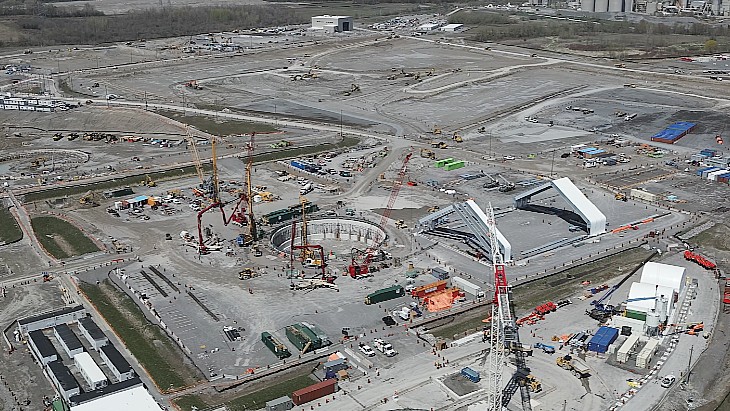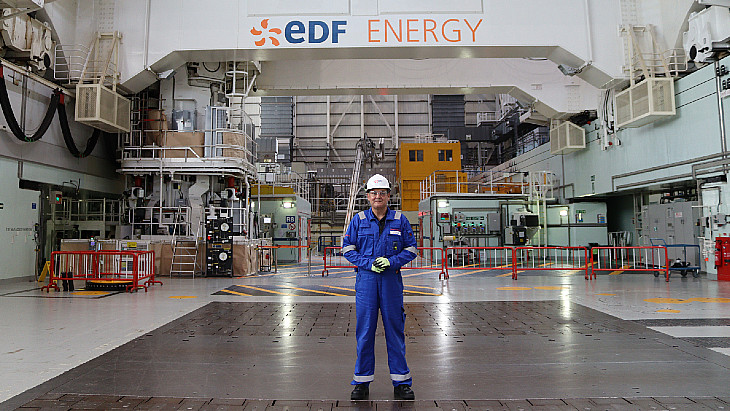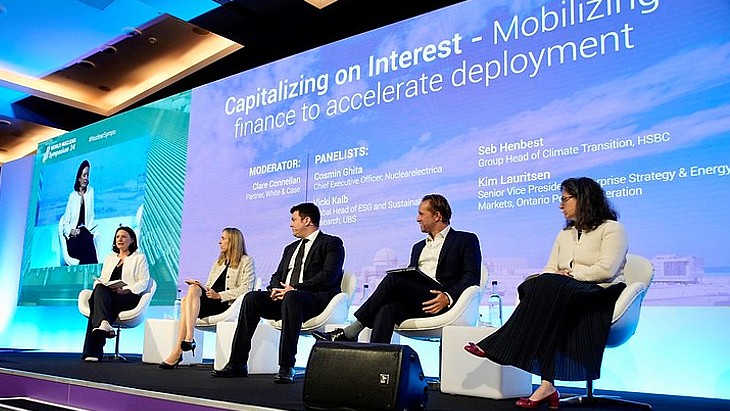Bringing lenders into UK nuclear
NuGeneration's project to build a nuclear power plant of up to 3.8 GWe gross capacity at Moorside in West Cumbria will be the first opportunity for lenders to enter the UK's nuclear power program, CEO Tom Samson told World Nuclear News in an interview.
Samson spoke on the side of the conference Nuclear Energy's Role in the 21st Century: Addressing the Challenge of Financing that was held in Paris last week. The event was jointly organised by the OECD Nuclear Energy Agency and the International Framework for Nuclear Energy Cooperation (IFNEC).
A joint venture between Toshiba and Engie, NuGen says it combines the strengths of its two globally-recognised parent companies, with proven operating and engineering experience, and AP1000 nuclear reactor technology provided by Westinghouse Electric Company, a group company of Toshiba. Sanmen 1 in China's Zhejiang province is expected to be the first AP1000 to begin operating. Four AP1000 reactors are being built in the USA - two each at Vogtle and Summer - while three AP1000s are also proposed for the Moorside site.
Prior to joining NuGen, in June 2015, Samson was Chief Operating Officer at Emirates Nuclear Energy Corporation (Enec), which is building four Korean-designed APR-1400 pressurized water reactors at Barakah nuclear power plant in Abu Dhabi.
What are you taking away from the discussions at this conference?
This conference has been great for building consensus and clarity on what the challenges are for financing of new nuclear. There are solutions out there, there are parties who can come to the table to help solve some of those challenges, whether they are export credit agencies (ECAs) or others. We're focused on finding solutions to the funding challenge by structuring our project in a way that will overcome those challenges. Technology selection is clearly already part of our structure with the AP1000, with Westinghouse and Toshiba and their ability to deliver projects as a key part of that. We benefit tremendously from the Contract-for-Difference (CfD) architecture that's already in place in the UK. We need to make that adaptable for bringing in lenders because a lender hasn't participated in the UK new nuclear market yet so that's got to be part of the solution as we go forward. If we can do that, by building on the attractiveness of the UK nuclear landscape and the government's commitment to new nuclear, by bringing in export credit agencies which strengthens the alliance between the UK, Japan and the US with our technology and investment participants, then we've got a much stronger basis on going forward with confidence to our Final Investment Decision (FID).
Which export credit agencies?
We're in discussions with the US and Japanese export credit agencies; we have Japanese investors and US technology and they are naturally the ECA lenders that we should be in dialogue with.
Are the CfD and Treasury Guarantee that EDF Energy has agreed with UK government for the Hinkley Point C project your benchmark figures?
I don't think I'd refer to them as benchmark figures; we will work within the CfD architecture and we will have our own figures. We're going to put our own numbers on the table when we've gone through our own engineering, procurement and construction (EPC) process and developed our own solutions and run through our own set of negotiations. I think that's clearly a reference point and we have to come forward with what we believe is our cost-competitive solution for nuclear in the UK.
Does that mean you could have a cheaper price per megawatt hour?
We could have.
What equity-debt split are you looking for?
We're exploring options, but we're not in a position to talk at that level of detail at this stage. The main thing from our perspective is bringing in debt and the debt financing solution on a structured basis at FID.
What's the attraction of that?
It allows us to finance the project because, at the end of the day we're not backed by a government. NuGen is a private investor vehicle. We have equity from private companies and not state entities and therefore we have to bring in more equity from other participants and the scale of the project requires us to find billions and billions of pounds of equity. We think we can manage that equity solution if we brought in debt; the scale of the debt is something we want to make sure we maximise. We'll have the Infrastructure UK Guarantee Scheme, but if we can bring in ECAs then that helps the government because it reduces their burden to provide a guarantee of the totality of our debt.
At which point will you have worked out your contract arrangements with government?
Our program to FID, through to the end of 2018, has got lots of streams to it. By next summer we want to start to have validated our financing strategy; we want to have got clarity from the ECAs that they buy into our funding assumptions, and similarly with the UK government that this is a validated approach. That's a natural point in the process to ensure that we are on the right path because the amount of investment required in this development phase is significant. Our shareholders get briefed every month, we have regular board meetings, and we have certain key milestones that we need to meet to make FID realistic. Our plan is to complete our Generic Design Assessment process by Q1 next year, to have our Development Consent Order (DCO) application submitted at the end of Q1 next year, to have a nuclear site licence application developed and ready to submit at the end of Q1/beginning of Q2 next year. They are the key development milestones that indicate we are making progress in the right direction. We have to continue our dialogue with the ECAs and the lenders to validate the assumptions we've submitted, and we have to go through a detailed and rigorous due diligence process with the ECAs and the UK government and that will take time. That due diligence process will hopefully flush out any issues for us to resolve and what the conditions to address there might be for financing. That's the process we're in now.
How does Toshiba's current financial health affect your project?
Toshiba is going through a recovery process to improve their balance sheet and to restore their financial strengths. That's an ongoing process. Their commitment to nuclear through their ownership of Westinghouse and their investment in NuGen has not changed and is in fact very much a central part of their strategy going forward. And Engie, our other shareholder, they like Toshiba are fully committed to NuGen.
If you were late with the FID, what would the shareholders do?
My intention is to come up with a process that allows us to move forward with confidence to FID. We're not going to rush it because we're going to go through a critical path which involves DCO and Secretary of State approval etc., but we have a target and we want to be able to get to that and then financially close. Because if it keeps moving out that just means we're having to spend more and more money before we've got funding certainty and having funding certainty and clarity and alignment is really important for us.
With demand for UK nuclear, there is no pressure on you in terms of winning a piece of the pie, but do you feel under pressure to be more successful than the other two projects?
No. I don't measure myself against EDF Energy or Horizon. NuGen are focused purely and simply on delivering the milestones that we need to get to FID, on building a consensus around our financing strategy, on structuring our EPC that's based on delivery price certainty. I'm not looking over my shoulder to where the other guys are because they don't really impede me in my ability to go forward. Clearly, a FID on Hinkley is an important milestone for validation of the UK strategy, but the UK strategy is based on the CfD and the Infrastructure UK Guarantee. We've fully bought into that and that is available to us and that is what we're focusing on. Whether EDF is going to achieve FID in the time available is a different matter. I'm confident they will and will get there eventually, but it isn't holding us up in making progress; it's not a condition that allows me to build a solution for NuGen. In fact, if anything, it increases the importance of the other new build projects moving ahead. The new build industry is contingent on a number of projects being put over the finishing line. I'm focused on delivering NuGen across that finishing line and that's what the government needs because it needs new nuclear build on the system. There are no obstacles in front of us that are being presented by the delay on FID for Hinkley. And at the same time we're working within the government's solutions that have already been created.
So the Treasury and the Department of Energy and Climate Change are with you in trying to meet those milestones?
Yes.
Is it important to you to have the first AP1000 reactors up and running as reference projects in order to get the IUK Guarantee?
We're going to be number 17, 18 and 19 in the AP1000 reactor fleet and the fleet approach is providing us with significant lessons learned that we are building into our project structure. We're looking forward to Westinghouse loading fuel in the first AP1000 within the next year. That's a massive milestone for the AP1000 and we're focused on that. We're learning a lot from the eight reactors that are being built; those lessons learned are being built in.
Which lesson would you highlight?
It's important that we progress in a proper sequenced fashion. For example, making sure that the bulk of the engineering is done before we get to first nuclear concrete, and that we've got regulatory clarity on the basis of our site specific solutions for the safety case before we start building facilities on site. Those elements are key lessons for successful delivery of an on-time and to-budget nuclear project.
What do you bring from your time at Enec?
The clear takeaways for me from the time in Abu Dhabi are certainly that government support and commitment up front is essential and we have that, though in a different form, in the UK. Secondly, the delivery and capability of your EPC consortium and how they can implement and build the project should never be underestimated. The choices you make in that space will define whether you sink or swim in the context of building your project and, clearly, the Enec team made some great decisions in that regard. The role of the owner in leading the project and in facilitating progress in consortia with the contractors, the regulators and the government is also important. That's another key lesson I learned - that you need a strong, purposeful, visible owner, which in this case is NuGen, which can manage the project, which can interface with the key stakeholders, who can advocate the highest qualities of safety and security and drive the project forward. The scale and complexity of delivering a nuclear project is quite overwhelming, so having the right team and the right capability, building on that reference plant concept, having a site that's already been built. In our case we've got eight reactors that have already been built and leveraging that knowledge in implementing this project will be the similar ingredients for us.
What about a comparison between vendors - Korea Hydro & Nuclear Power and Westinghouse?
I'm not going to make a comparison; it would be like saying which of your children is more beautiful!
What's the key point you've heard at the NEA/IFNEC conference?
Market uncertainty and market dysfunction will continue to be a barrier for new nuclear deployment. Overcoming that, like the UK has done with the CfD, is step one. Solving the funding challenge that is not entirely dependent on a government funded solution is the next challenge. Here we have to explore ways to access export credit agencies and other sources of debt to make the funding a realistic target.
But isn't the CfD just a sticking plaster instead of reform of the market?
No. What CfD does is to provide a solution within that liberalised market that will give confidence to investors to come forward. DECC has a pipeline of projects, there are multiple investors at the table looking to progress those forward and we have to solve the financing challenge still. Even for a company as large as EDF that's not an easy thing to do; they're still trying to secure FID on that basis. So the financing challenge is the main challenge in the near term for the industry in the UK. We've got the benefit of the CfD, we've got the opportunity to access the IUK Treasury Guarantees. We need to create projects that will allow us to benefit from both of those and bring in debt if we're to go forward and start building these plants in the next couple of years.
Comments? Please send them to editor@world-nuclear-news.org

_88592.jpg)







